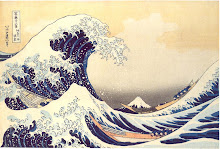Here are some answers to questions students asked about my research.
1. I met my co-author through another Japanese colleague when I was visiting him at the Center for Spatial Information Science at Tokyo University. I had read Dr. Zaiki's articles before and knew she might have some interest in historical typhoons. We communicate by email. I visit Japan every summer and she usually comes to St. Louis each year as well.
2. I can speak and read some Japanese and Dr. Zaiki can speak and write English very well.
3. We have been working on this project for about five years. It takes a long time to collect data, do the analysis, and do presentations and write papers. We can often publish parts of the research as we go along. One of our papers was published in the international journal Weather in 2009 (Reconstructing typhoons in Japan in the 1880s from documentary records).
4. I became interested in typhoons because my PhD dissertation research was about flooding in Japan and typhoons are the major cause of flooding.
5. One of the most interesting parts of my research is reading English-language newspapers published in Japan from the 1850s to 1890s. It is very interesting to read about events in Japan and the world during this time. Things were changing very fast in Japan as it opened to the west during these years. Also, it is amazing how similar newspaper stories are to those we read today.
6. Doing research is part of the job of a professor so we need to make time for it. Summers are a good time for me since I don't teach in July and early August. Anyway, I like doing research so I can find time and the money to do it.
Another project, we have been working on involves "Typhoon tracks around Japan from 1951 to 2011." We are using Geographical Information Systems software to map and classify typhoon tracks around Japan so we can use this information to better understand typhoons we have been researching in the 19th century.
Here is a link to a really interesting site about typhoons - Digital Typhoon
Here are some images we made with ESRI's software ArcGIS.
 |
| Pacific Coast Typhoons around Japan 1951-2009 |
 |
| General Pacific Coast type typhoon tracks |
 | |||
| General typhoon tracks around Japan 1951-2009 |
















